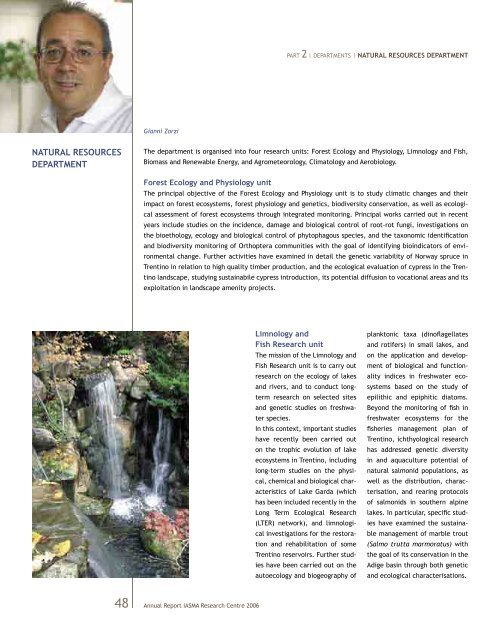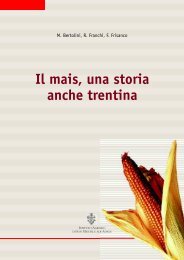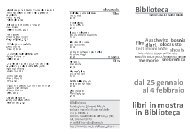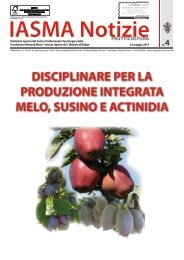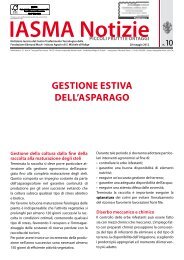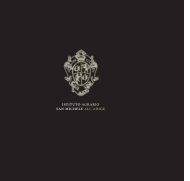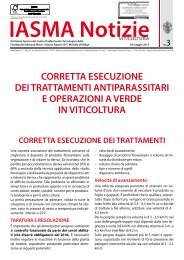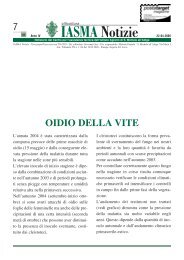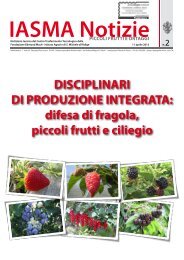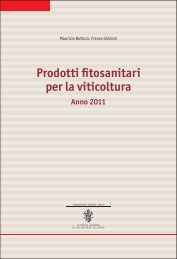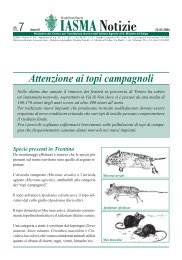Istituto Agrario di San Michele all'Adige (IASMA - Fondazione ...
Istituto Agrario di San Michele all'Adige (IASMA - Fondazione ...
Istituto Agrario di San Michele all'Adige (IASMA - Fondazione ...
Create successful ePaper yourself
Turn your PDF publications into a flip-book with our unique Google optimized e-Paper software.
NATURAL RESOURCES<br />
DEPARTMENT<br />
Gianni Zorzi<br />
48 Annual Report <strong>IASMA</strong> Research Centre 2006<br />
PART 2 | DEPARTMENTS | NATURAL RESOURCES DEPARTMENT<br />
The department is organised into four research units: Forest Ecology and Physiology, Limnology and Fish,<br />
Biomass and Renewable Energy, and Agrometeorology, Climatology and Aerobiology.<br />
Forest Ecology and Physiology unit<br />
The principal objective of the Forest Ecology and Physiology unit is to study climatic changes and their<br />
impact on forest ecosystems, forest physiology and genetics, bio<strong>di</strong>versity conservation, as well as ecological<br />
assessment of forest ecosystems through integrated monitoring. Principal works carried out in recent<br />
years include stu<strong>di</strong>es on the incidence, damage and biological control of root-rot fungi, investigations on<br />
the bioethology, ecology and biological control of phytophagous species, and the taxonomic identifi cation<br />
and bio<strong>di</strong>versity monitoring of Orthoptera communities with the goal of identifying bioin<strong>di</strong>cators of environmental<br />
change. Further activities have examined in detail the genetic variability of Norway spruce in<br />
Trentino in relation to high quality timber production, and the ecological evaluation of cypress in the Trentino<br />
landscape, studying sustainabile cypress introduction, its potential <strong>di</strong>ffusion to vocational areas and its<br />
exploitation in landscape amenity projects.<br />
Limnology and<br />
Fish Research unit<br />
The mission of the Limnology and<br />
Fish Research unit is to carry out<br />
research on the ecology of lakes<br />
and rivers, and to conduct longterm<br />
research on selected sites<br />
and genetic stu<strong>di</strong>es on freshwater<br />
species.<br />
In this context, important stu<strong>di</strong>es<br />
have recently been carried out<br />
on the trophic evolution of lake<br />
ecosystems in Trentino, inclu<strong>di</strong>ng<br />
long-term stu<strong>di</strong>es on the physical,<br />
chemical and biological characteristics<br />
of Lake Garda (which<br />
has been included recently in the<br />
Long Term Ecological Research<br />
(LTER) network), and limnological<br />
investigations for the restoration<br />
and rehabilitation of some<br />
Trentino reservoirs. Further stu<strong>di</strong>es<br />
have been carried out on the<br />
autoecology and biogeography of<br />
planktonic taxa (<strong>di</strong>nofl agellates<br />
and rotifers) in small lakes, and<br />
on the application and development<br />
of biological and functionality<br />
in<strong>di</strong>ces in freshwater ecosystems<br />
based on the study of<br />
epilithic and epiphitic <strong>di</strong>atoms.<br />
Beyond the monitoring of fi sh in<br />
freshwater ecosystems for the<br />
fi sheries management plan of<br />
Trentino, ichthyological research<br />
has addressed genetic <strong>di</strong>versity<br />
in and aquaculture potential of<br />
natural salmonid populations, as<br />
well as the <strong>di</strong>stribution, characterisation,<br />
and rearing protocols<br />
of salmonids in southern alpine<br />
lakes. In particular, specifi c stu<strong>di</strong>es<br />
have examined the sustainable<br />
management of marble trout<br />
(Salmo trutta marmoratus) with<br />
the goal of its conservation in the<br />
A<strong>di</strong>ge basin through both genetic<br />
and ecological characterisations.


